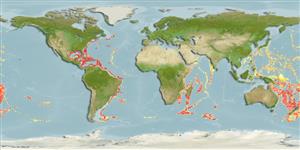Common names from other countries
>
Ophidiiformes (Cusk eels) >
Ophidiidae (Cusk-eels) > Neobythitinae
Etymology: Bassogigas: Latin, bassus = thick, fat + Latin, gigas, gigantis = giant (Ref. 45335).
More on authors: Goode & Bean.
Environment: milieu / climate zone / depth range / distribution range
Ecologie
marien bathydemersaal; diepte 637 - 2239 m (Ref. 75877). Deep-water
Indo-West Pacific (between the southern tip of South Africa and New Caledonia) and Atlantic (except east Atlantic).
Grootte / Gewicht / Leeftijd
Maturity: Lm ? range ? - ? cm
Max length : 85.0 cm TL mannelijk / geslacht onbekend; (Ref. 4103)
Korte beschrijving
Determinatiesleutels | Morfologie | Morfometrie
Dorsale stekels (totaal) : 0; Dorsale zachte stralen (totaal) : 103 - 110; Anale stekels: 0; Anale zachte stralen: 82 - 88; Wervels: 60 - 64. This species is distinguished and differs from B. walkeri by its long lateral line, snout to end of lateral line 64-80% SL (vs. 39.5% SL) and ending below dorsal fin ray number 47-69 (vs. 10) and above vertebra number 31-43 (vs. 12); scales in midline of body 130-150 (vs. 175); distance between base of pelvic fins and anal fin origin 24.0-32.5% SL (vs. 34.5% SL); two median basibranchial tooth patches, the anterior short and broad (vs. long and narrow); scale rows between origin of dorsal fin and lateral line 7-8 (vs. 11); sagitta thin, 12-16% its height (vs. 23% its length) (Ref. 86400).
Uncommon species (Ref. 34024). Oviparous, with oval pelagic eggs floating in a gelatinous mass (Ref. 205).
Levenscyclus en paargedrag
Maturities | Voortplanting | Spawnings | Egg(s) | Fecundities | Larven
Nielsen, J.G. and P.R. Møller, 2011. Revision of the bathyal cusk-eels of the genus Bassogigas (Ophidiidae) with description of a new species from off Guam, west Pacific Ocean. J. Fish Biol. 78(3):783-795. (Ref. 86400)
Status op de Rode Lijst van het IUCN (Ref. 130435)
CITES (Ref. 128078)
Not Evaluated
Gevaar voor de mens
Harmless
Gebruik door de mens
Visserij: van geen belang
Tools
Speciale rapporten
Download XML
Internetbronnen
Estimates based on models
Preferred temperature (Ref.
115969): 2.5 - 7.4, mean 4.6 (based on 889 cells).
Fylogenetische diversiteitsindex (Ref.
82804): PD
50 = 0.7500 [Uniqueness, from 0.5 = low to 2.0 = high].
Bayesian length-weight: a=0.00110 (0.00041 - 0.00296), b=3.08 (2.85 - 3.31), in cm Total Length, based on LWR estimates for this (Sub)family-body shape (Ref.
93245).
Trofisch niveau (Ref.
69278): 3.7 ±0.6 se; based on size and trophs of closest relatives
Weerstandsvermogen (Ref.
120179): Gemiddeld, minimale populatieverdubbelingstijd 1,4-4,4 jaar (Preliminary K or Fecundity.).
Fishing Vulnerability (Ref.
59153): Moderate to high vulnerability (54 of 100).
